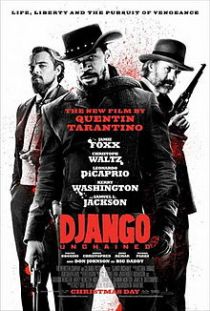Every film that takes historical events as the core of the story it tells is not a documentary. To that end, Django Unchained does not claim to be a documentary about slavery and it is not a documentary about slavery. The film offers a fictive take on the antebellum period in United States history and captures the brutality, licentiousness, depravity, incestuousness, and ugliness of what black feminist scholar bell hooks calls “white supremacist capitalist patriarchy” very, very well. So if we do go to the movies to “learn stuff” as hooks asserts, Django Unchained enables a long look at the everyday humiliations of the dehumanization that slavery involved and the daily (sexual) perversions it maintained as it permeated every aspect of American life. In the film itself, Django represents the hope that the enslaved created for themselves through dissemblance, absconding, the establishment of fictive kinship networks, worship, marriage, storytelling, dancing, and music.
A very dear friend of mine aptly calls Django Unchained “Faulkneresque.” This description brilliantly captures what she terms the “Southern Gothic” very well represented in this film; it is macabre. The “Mandingo fights,” the “fancy girl” network, the hinting towards incestuousness in Quentin Tarantino’s film appear as direct references to William Faulkner’s Absalom, Absalom! One of the more powerful scenes in the film for me occurs when Dr. King Schultz recalls Calvin Candie’s dogs ripping an enslaved man apart; the memory haunts him. This representation of a traumatic memory underscores the powerful and peculiar impact of slavery’s violence to actively render the past a present catastrophe. Thus, time’s passage does not permit an easy escape from the horrors of this sadistic institution.
Unlike Margaret Mitchell’s Gone with the Wind, Django Unchained resists romanticizing slavery. The love story between Django and Broomhilda doesn’t romanticize slavery, as a nod towards historical understanding, their love story represents resistance of slavery. Despite slaveholders’ propaganda, slavery was not a system designed to benefit and enhance the lives of the enslaved. Narratives like Mitchell’s depicting kindly, benevolent slaveholders who take good care of their slaves misrepresents extreme paternalism and the violence of owning and commanding human chattel. If life became worthwhile for the enslaved, it was because they made it so. Marriage served as a site for just such a possibility. In Help Me to Find my People: The African American Search for Family Lost in Slavery, Heather Andrea Williams notes the role that marriage played in the interior lives of enslaved men. For some, she notes that “it could be an antidote for loneliness and emotional pain […] For some, marriage was what made the hard labor and abuse of slavery bearable. For others it was an act of soul preservation.” In recording the reflections of Francis Fredric, a man enslaved in Virginia and Kentucky, Williams reports his suggestion that “marriage and family served as the sole outlet for their emotions.” Continuing, Fredric believed that “some men focused all their affection on their wives and children because they had nothing else, no career or material possessions to compete for their attention or to give them a feeling of worth. Sometimes, too, marriage and fatherhood presented the only opportunity to exert a sense of power, ownership, or protectiveness, feelings not generally allowed to enslaved men.” This discussion of marriage and the suggestion of loving bonds suggests the active, use value of love. For the enslaved, love between them was about facilitating whatever semblance of life they could manage in the confines of their bondage. While Django Unchained used a romantic fairytale as a frame, ultimately, I think it showed an understanding that love between the enslaved had to be useful. In the film, usefulness is murderous but historically, usefulness wasn’t limited in this way, as Mr. Fredric’s testimony attests.
My friend Carmen has been hosting a series of wonderful posts about an “anti-princess campaign for young black women and girls” that will focus the writing courses she teaches. Her reflections on the limits of popular, fairy tale romance, especially for young black women and girls, have certainly impacted how I am processing Django Unchained. In one of Carmen’s posts, she uses the Williams book to discuss a fantastic assignment that she will require of her students. The kind of imaginative work that she is asking her students to do reminds me of the question my mother posed to me at the conclusion of Django Unchained: “So what’s going to happen to them after this? Do they even make it out of Mississippi?” What kind of life was possible for black people in such horrific circumstances? Coming to imagine the possibilities of how black Americans made lives for themselves requires doing the kind of work that Carmen has planned for her class. It is work that involves the archives and not simply going to the movies.
